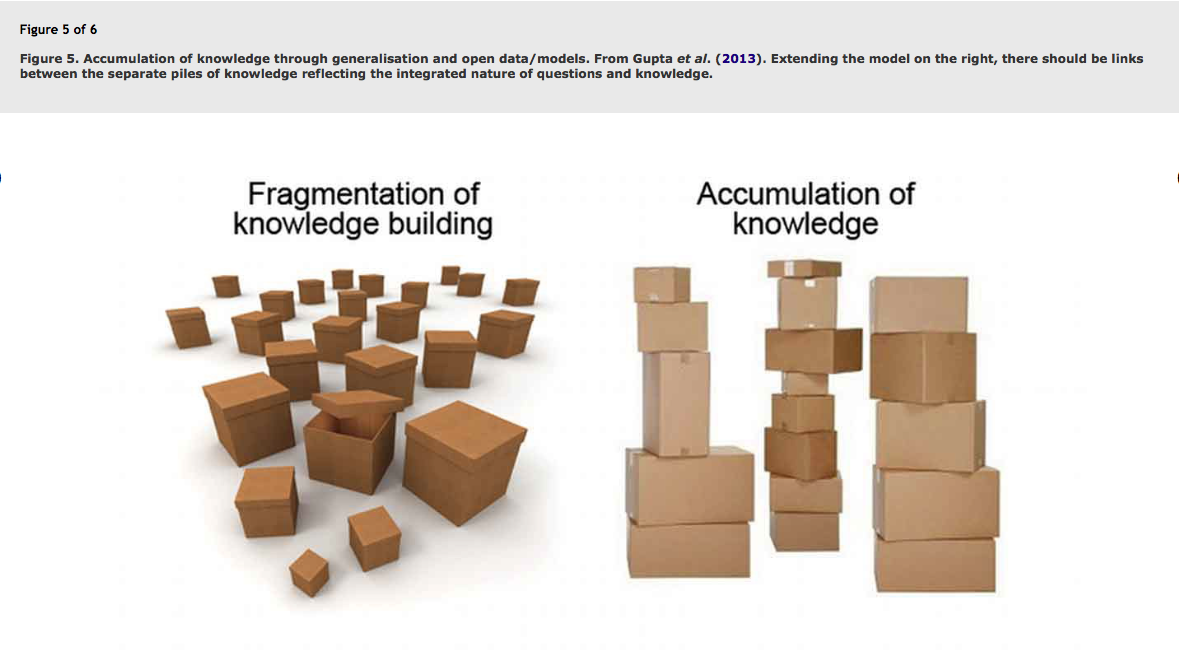博文
23个悬而未决的水研究领域的问题
|||
2019年6月,IAHS(国际水文学会)根据学者讨论并投票,选出来了23个悬而未决的水研究领域的问题。
文章链接在此https://doi.org/10.1080/02626667.2019.1620507
这23个问题分别是:
时间变异和未来变化
1.水文循环在气候和环境变化下是否在区域内加速/减速,是否存在引爆点(不可逆转的变化)?
2.寒冷地区径流和地下水如何随气候变暖而变化(例如冰川融化和永久冻土融化)?
3.气候变化和用水改变(半)干旱地区间歇河流和地下水的机制是什么?
4.土地覆盖变化和土壤干扰对地表水和能量通量以及由此产生的地下水补给的影响是什么?
空间变异和尺度问题
5.是什么导致径流,蒸发,地下水和物质通量(碳和其他营养物质,沉积物)的空间异质性和均匀性,以及不同参考变量的敏感性(例如降雪状态,干旱,反应系数)?
6.流域尺度的水文规律是什么?它们如何随尺度变化?
7.为什么大多数土壤优势流(Preferential flow)能跨越于多个尺度,这种行为如何与关键带(Critical Zone)共同演化?
8.为什么河流对降水输入的响应如此之快,但暴雨径流却是经年之水?陆地水循环中水的流动时间分布是多少?
极端事件的变异
9.洪水多发时期和干旱多发时期是如何产生的?它们是否发生变化;如果是,为什么呢?
10.为什么某些流域的径流极值对土地利用/覆盖和地貌变化比其他流域更敏感?
11. 积雪降雨(Rain on Snow)事件中产生特殊的径流,何因、何法、何时?
水文界面
12.控制“山坡-河岸湿地-河流-地下水”之间交互的过程是什么?何时连接?
13.控制地下水的边界流量的过程是什么(例如地下水补给,流域间交互和入海汇流)?
14.影响水质下降的长期、持续存在的因素是什么?
15.新关注的污染物的范围,过程和影响是什么?如何去除或者杀死地下系统里的微生物病原体
观测和数据
16.如何利用新技术测量地表、地下的时空上的特征,状态和通量?
17.与软数据(非专业人员的定性观测,数据挖掘等)相比,传统水文观测相对价值是什么?在什么条件下可以用海量空间数据替代长期观测?
18.我们如何从人类和水系统的现有数据中提取信息,以辅助“社会-水文模型”和概念的构建过程?
建模方法
19.如何调整水文模型以便模型根据不断变化的条件进行未来预测,包括改变植被的变化?
20.我们如何在水文预测中解惑并减少模型结构/参数/输入的不确定性?
与社会接轨
21.如何将水文预测中的确定性和不确定性传达给决策者和公众?
22.与水管理有关的社会目标(例如水 - 环境 - 能源 - 食品 - 健康)之间的协同作用和权衡是什么?
23.水在移民,城市化和人类文明动态中的作用是什么,对当代水管理有何影响?
有的问题提出来快一个世纪了,不过不是热点问题,本身也很难,所以一直都没什么人关心,最热的还属气候变化和数据挖掘——这俩问题是个人就能讲几句。 显然评选的人当中做模型的人很少,只有两个问题,而且问题也不够深;当然模型本身就是利用和反应科学对于问题认识的物理性的工具,规律本身认识不清楚,必然也限制模型的发展。
文章中讲知识的积累可以将零落的知识碎片堆积起来变成知识塔。 但我觉得有一些新发现往往能推翻已经堆好的了的知识塔.

比如下图的发现,就推翻了不少“旧”的认识,但是这个问题还没有新的可靠求解办法,于是现在还都在沿用旧的。 这个问题就是前面提到的问题8,为什么洪水响应这么快,但是流进河流里面的水却还是旧水——来自地下水或者更深层的地下水。 这意味着我们过去认为地表地下水的不同流动速度(地表快地表贡献高所以洪水应该是新水)的认识有问题,对于地下水对变化的响应速度估计有问题,意味着里面可能藏着一个巨大的未发现的基本物理规律。 我对这个问题也没有好的认识,Keith Beven的《Rainfall-Runoff Modeling》有详细讨论。

英文原文:
The 23 unsolved problems in hydrology identified by the community process in 2018.
Time variability and change
Is the hydrological cycle regionally accelerating/decelerating under climate and environmental change, and are there tipping points (irreversible changes)?
How will cold region runoff and groundwater change in a warmer climate (e.g. with glacier melt and permafrost thaw)?
What are the mechanisms by which climate change and water use alter ephemeral rivers and groundwater in (semi-) arid regions?
What are the impacts of land cover change and soil disturbances on water and energy fluxes at the land surface, and on the resulting groundwater recharge?
Space variability and scaling
5. What causes spatial heterogeneity and homogeneity in runoff, evaporation, subsurface water and material fluxes (carbon and other nutrients, sediments), and in their sensitivity to their controls (e.g. snow fall regime, aridity, reaction coefficients)?
6. What are the hydrologic laws at the catchment scale and how do they change with scale?
7. Why is most flow preferential across multiple scales and how does such behaviour co-evolve with the critical zone?
8. Why do streams respond so quickly to precipitation inputs when storm flow is so old, and what is the transit time distribution of water in the terrestrial water cycle?
Variability of extremes
9. How do flood-rich and drought-rich periods arise, are they changing, and if so why?
10. Why are runoff extremes in some catchments more sensitive to land-use/ cover and geomorphic change than in others?
11. Why, how and when do rain-on-snow events produce exceptional runoff? Interfaces in hydrology
12. What are the processes that control hillslope–riparian–stream–groundwater interactions and when do the compartments connect?
13. What are the processes controlling the fluxes of groundwater across boundaries (e.g. groundwater recharge, inter-catchment fluxes and discharge to oceans)?
14. What factors contribute to the long-term persistence of sources responsible for the degradation of water quality?
15. What are the extent, fate and impact of contaminants of emerging concern and how are microbial pathogens removed or inactivated in the subsurface?
Measurements and data
16. How can we use innovative technologies to measure surface and subsurface properties, states and fluxes at a range of spatial and temporal scales?
17. What is the relative value of traditional hydrological observations vs soft data (qualitative observations from lay persons, data mining etc.), and under what conditions can we substitute space for time?
18. How can we extract information from available data on human and water systems in order to inform the building process of socio-hydrological models and conceptualisations?
Modelling methods
19. How can hydrological models be adapted to be able to extrapolate to changing conditions, including changing vegetation dynamics?
20. How can we disentangle and reduce model structural/parameter/input uncertainty in hydrological prediction?
Interfaces with society
21. How can the (un)certainty in hydrological predictions be communicated to decision makers and the general public?
22. What are the synergies and tradeoffs between societal goals related to water management (e.g. water–environment–energy–food–health)?
23. What is the role of water in migration, urbanisation and the dynamics of human civilisations, and what are the implications for contemporary water management?
https://blog.sciencenet.cn/blog-43276-1189069.html
上一篇:海外工作机会——地球、湖泊、水文、环境、冰川方向 (美国,加麻大,沙特, 2019-06-11)
下一篇:Nature2018年最有影响力的50篇地学研究